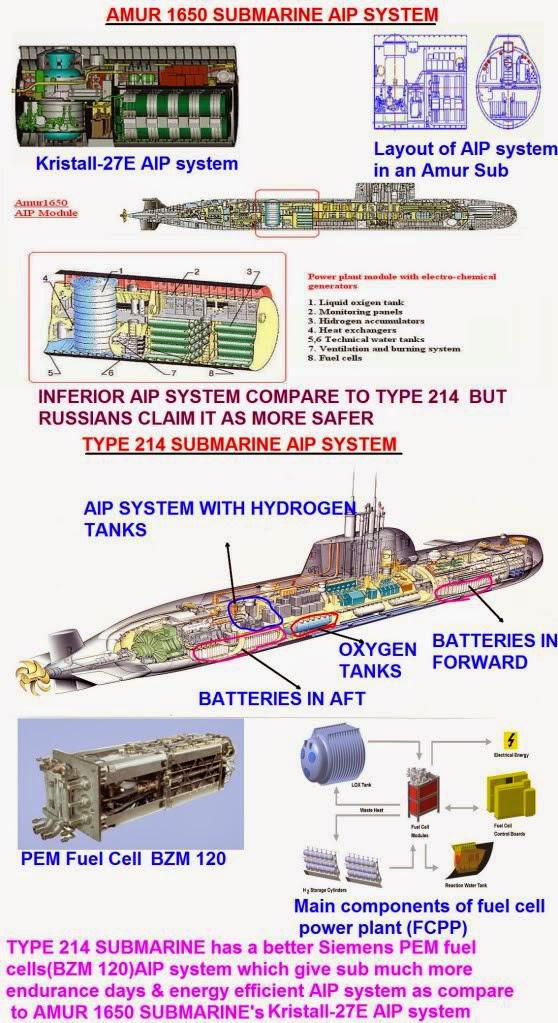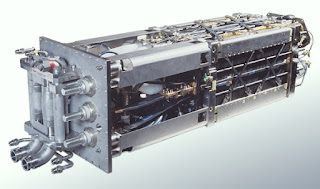Illustrated by the Type 214 submarine - it shows how potentially difficult it may be to rearrange the Proton Exchange Membrane Fuel Cell (PEMFC) AIP and "Main components" (FCPPs) when replacements are required. Type 214s apparently use a large hatch. But such a hatch or hull cutting may weaken the hulls of deep diving Soryus. (Diagram originally from thaifighterclub.org)
---
A SINAVY PEM Fuel Cell module. Difficult to squeeze such a large awkward item into a submarine while rearranging parts already in the submarine. The module's dimensions are 500mm x 530mm x 1.47 meters long (making for a 500mm x 530mm diagonal measurement of approximately 720mm (too big to squeeze through a torpedo tube!)
---
In Commentson June 24, 2015 at 9:48 PM“S” raised the following interesting issues. I have altered some of the English for clarity:
The Japanese Ministry of Defence (MOD) was researching fuel cell AIP but decided to end this research. The MOD indicated one of the main reasons was that it could not overcome the issue of hull-cutting required when exchanging fuel cell stacks. The lifetime of a Proton Exchange Membrane Fuel Cell (PEMFC) is 40,000 hours for continuous running. But for actual submarine operations, the lifetime is expected to be shorter because of adverse effect of inevitable start-and-stop conditions. In a test taking into account realistic start-and-stop cycles the estimated lifetime of the PEMFC AIP is 2,000-4,000 hours.
[S provided the source for the above figures which is http://batteryuniversity.com/learn/article/fuel_cell_technology[Last updated May 4, 2015]:
“If operated in a vehicle, the PEMFC stack has an estimated service life of 2,000-4,000 hours. Start-and-stop conditions induce drying and wetting that contribute to membrane stress. Running continuously, the stationary stack is good for about 40,000 hours. Stack replacement is a major expense.]
“If operated in a vehicle, the PEMFC stack has an estimated service life of 2,000-4,000 hours. Start-and-stop conditions induce drying and wetting that contribute to membrane stress. Running continuously, the stationary stack is good for about 40,000 hours. Stack replacement is a major expense.]
S added “[Lithium-ion Batteries] LIBs and Lead Acid Batteries can be exchanged through a [Soryu’s existing hatch], but PEMFCs cannot. A PEMFC is too big. It means that we would have to exchange a PEMFC by hull-cutting, which is very complicated and expensive and includes rearrangement or adjustment of hydrogen stage or delivery system. Various impacts (reduction in hull strength, life shortening, hull-cutting and rewelding periods, verification periods, increase cost, etc) must be considered every 4,000[?] hours or less running time.
[S asked the following questions]
1. How many times do we have to cut the hull during the 22 years of operating a Japanese submarine?
2. Should we avoid possible hull-cutting by significantly reducing the operating period of a Japanese submarine?
I asked whether squeezing the PEMFC into the submarine through a torpedo tube was possible (I measured the
S responded that it might be possible to fit a PEMFC through a hatch as occurs with German submarines.
The illustrations of PEMFC at the top of the article are probably the most helpful - also see http://www.industry.siemens.com/verticals/global/de/marine/marineschiffe/energieverteilung/Documents/sinavy-pem-fuel-cell-en.pdfFig.5 (page7) of and Table (page9).
MHalblaub indicated that on http://www.industry.siemens.com/verticals/global/de/marine/marineschiffe/energieverteilung/Documents/sinavy-pem-fuel-cell-en.pdfpage 10 ' that a SINAVY PEM fuel cell module size is 500mm x 530mm x 1.47 meters.
COMMENT
Japan has a whole range of technical tradeoff (costs and benefits) decisions to make. For example making a large hatch in the hull to exchange PEMFCs may weaken the hull for especially deep diving Soryus.
Please connect with my article Air Independent Propulsion (AIP) Technologies and Selection, August 5, 2014 http://gentleseas.blogspot.com.au/2014/08/air-independent-propulsion-aip.html
Pete

